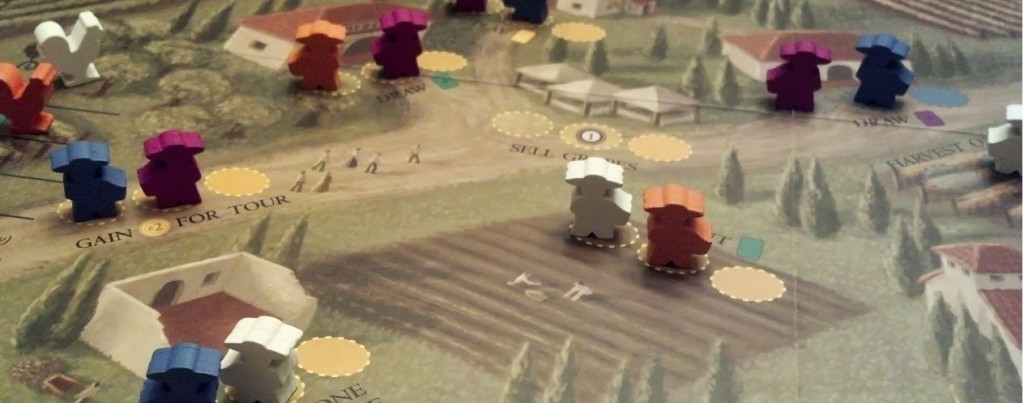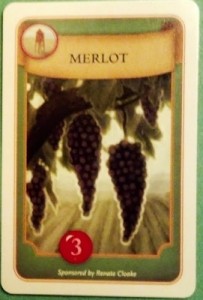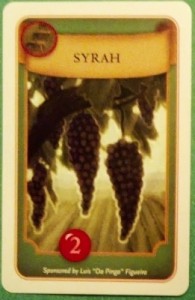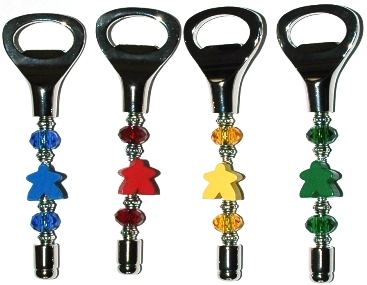Note: This review pertains to the First Edition of Viticulture.
Gamers are a geeky bunch. We all know this, and we wear that badge with pride. Still, even the most serious gamers among us don’t tend to be the most suave individuals. As a group, we’re sociable, creative, endearing, entertaining, quirky, and passionate – but not very cosmopolitan. “Do you want to come over and play board games?” doesn’t exactly invite that sort of imagery. We know it, and we’re fine with that.
The reasons behind this are numerous and varied, touching upon topics from socioeconomics, to age, location, stereotypes and acceptance issues from our culture at large.
Oh, and the games themselves.
It’s difficult to keep that posh air about you when the game is about dragons, trains, or rocket ships to outer space, and your goal is to move pieces of wood around a cardboard mat.
Could a game about wine bridge the divide, giving us just a modicum of maturity while we’re enjoying our geeky pastime?
And if not, how about just the illusion of it? Because we’ll take that too.
The Premise
In this race for quality product, players are rival Italian winemakers looking to rack up the best, most efficient winery. Players start off with some seeds, a patch of land, and a dream. With it, they’ll have to leverage their meager starting resources towards growing more crops, turning grapes into wine, and ensuring that their cellars are stocked with the best salable product for their patrons.
The Rules:
Much like many in its genre, Viticulture is a worker-placement game that, unlike similar games, is rather quick to set up. The game has four decks that go on the main board: the Green vine cards for planting, Purple wine order cards, and two sets of decks depicting various visitors to the vineyard that provide useful one-shot benefits (Yellow for Summer, Blue for Winter). Each player receives their own player board and an assortment of meeple pieces. Players start with three coin, three workers, a Pinot vine card, and a summer visitor card.
The game is played over a series of rounds, with each round depicting one year on the vineyards. Each round has four phases, appropriately named for the seasons. In Viticulture, worker placement is done during two different phases, but players only have one pool of workers for the entire round. Therefore, players will need to plan ahead. They should also consult the rule book for full explanation on all the actions available.
The oldest player receives the first player token. In Spring, the turn order for the round is set by players choosing which turn position they would like. Every position besides going first comes with a reward of some kind, be it an extra card, coin, VP, or temporary worker.
In Summer, players take turns using their workers on the various Summer (Yellow) actions, such as building improvement structures and planting fields. Players continue taking actions, or they can opt to save their remaining workers for the Winter actions and pass.
In the Fall, each player chooses to draw a card from either the summer visitor deck or the winter visitor deck.
Winter behaves similarly to Summer, wherein players take turns using their remaining available workers on the Winter (Blue) actions such as harvesting grapes, bottling wine, or selling wine orders for VP.
Once all players have finished taking actions, the round ends. In this, players retrieve their workers, age their grapes & wine, and collect money from completing past orders. Lastly, the first player token is rotated so that a new year can begin. The first player to reach 20 VP triggers the end of the game, and the end of that year will yield the winner, along with a nice Chardonnay.
The losers will have to convert to the production of boxed wine.
The Grapes Don’t Rot
As the gaming world continues to evolve, the line between American-style and Euro-style games is becoming more and more difficult to define. Traditionally, a worker placement game was considered a very Euro style. Players have a multitude of different strategies available to them, and they often require some thinking ahead. The early worker placements tended to be equally low on luck and visual aesthetics, focusing instead on keeping players interested through the tactical decision-making of Placing Unit X to get Action Y.
Viticulture is part of the newer generation of worker placement games that does care about ascetics. A lot. The artwork alone proves that: all of the artwork is a distinctly Italian fresco style, adding a stylistic and fitting nod to the game’s theme.
From the uniquely carved wooden pieces used for your farm improvements to the burlap bag holding the grape tokens, Viticulture displays what its world is about in a very appealing manner. Immersionists, if there ever was a game that goes above and beyond simply for your benefit, this would be it.
On the gameplay level, you are equally rewarded. There is plenty of depth for you to make multiple good moves each round. What’s more, unlike some worker placement games that can directly or indirectly punish you because of a misstep or two, Viticulture is a little more forgiving. While you can occasionally get locked out of certain actions (because someone got to them first), Viticulture avoids compounding the issue in three ways:
- Because there are no set rounds, you often have time to make up lost ground in a future turn, and you can opt for the bonus-lacking first player spot to aid you in your quest.
- Like the vines you’re cultivating, the game allows for flexibility. If an early strategy is blocked off or not working, you can adjust and not feel out of the running. (Cue the Tactician cheers.) It takes time to plant grapes, harvest them, crush them, turn them into wine, and then ultimately sell them for money and VP. (You know, kind of like real life.) A few well-timed wine orders can take a player from last place to first in short order. Players don’t feel that sense of futility in Viticulture that can happen with some worker placement games if things go poorly early on.
- The visitor cards add the luck to the game, as you aren’t sure what benefits they will offer you. Sure, sometimes you may end up with a not-so-useful visitor, other times they will be quite rewarding. Acting as an equalizing factor, visitor cards can easily be incorporated into your strategy, or they can simply help you catch up in areas you may be falling behind in.
Viticulture wants you to enjoy being in the Tuscan countryside while still having complex decision-making options. The final proof is that the grapes don’t rot. Really. In Viticulture, the crushed grapes age just like the bottled wine, and it’s the one deviation from reality in the whole presentation. It’s partly done for mechanical and balance reasons, but it also illustrates that this certainly is not a traditional Eurogame.
Just Don’t Call it Champagne
Theme matters when selecting a game – there’s a reason that simply reskinning games can increase your player base even if a game is already successful. It also proves that there’s a game out there for everyone.
Viticulture exudes flavor in every facet, but you don’t have to know a single thing about wine in order to play (and enjoy) Viticulture. The rules of the game don’t punish a player less knowledgeable about the subject matter, nor does it strategically reward someone who does. At no point do you ever feel disadvantaged simply because of the theme.
Case in point: we are not sophisticated wine connoisseurs by any stretch of the imagination, and we couldn’t tell you the difference between a Syrah and a Merlot, besides that they’re both red and tasty.
It is weird to say, then, that one of the game’s biggest accomplishments is also its one notable hangup. That is, the theme can be a deterrent.
Yes, its one potential issue is getting it to the table. Viticulture is not your standard flavor worker placement game, and this can give people pause. It even did for us initially. Yet just part-way through our first game, we our reservations proved completely unfounded. For someone browsing for new games, however, they could miss out on this simply because of surface inspection. For those who don’t inherently find farming or wine enticing, Viticulture could be passed over in favor of more traditional themes.
Still, given that the main concern here isn’t about mechanics, rules, or the quality of components, but rather that Viticulture (through no fault of its own) invites people to judge the book by its cover, that should tell you something about the caliber of game you’re getting here.
Soft, With a Nice Finish
It’s already a given that Immersionists and Tacticians will appreciate this game, but not every group is going to find Viticulture as beloved as them. Architects do come close though. Between building wooden structures on their vineyard, planting multiple crops, and ultimately stocking their cellars with their finest wines, they’ll enjoy the feeling of progression as their hard work pays off. But you don’t win by keeping the wine. So, selling off their profitable wares may feel a little disappointing. They’ll enjoy how the game is played, but not necessarily how it’s won.
Curiously, Socializers may also be entertained by Viticulture. Socailizers generally eschew worker placement games because they’re longer than they’d prefer, and they require more strategic thinking than Socializers usually like. Viticulture is on the shorter end of the worker placement spectrum though at 45-90 minutes. Pair this fact with the meta-game scene the game encourages – being in a comfortable setting with good wine and good company – and many Socializers will likely want to at least give it a try.
Strikers, on the other hand, won’t be enamored with Viticulture. It’s purposely less antagonistic than games of its kind, and while the prospect of achieving their goals is always enticing, they’ll find it difficult to get into with a game with this theme. Think about it: do you really want aggressive wine drinkers at your table?
Daredevils will have a similarly difficult time (as they often do with worker placement games). There is a random element with the visitor cards and each person’s actions each round, but Viticulture ultimately rewards planning. They too may be better in passing on this. It’s kind of hard to randomly sell wine.
The Takeaway
For their debut game, Stonemaier Games’s Viticulture hits a lot of the right marks in order to make an impression on an ever-growing market. It drips with flavor across all aspects of the game (with some to spare), while managing to to make something fresh and exciting by adding its own twist on the worker placement mechanic. Having to split your workers between two different phases of the game causes players to think ahead, and yet the game is never encumbered by complexity.
Viticulture was designed to be competitive without being combative and be accessible to a wide player base. It even scales to six players without adding extra time into the equation. The theme has the potential to be a little off-putting from players who aren’t really into wine, but if you can get them to sit down and play, there’s a good chance they’ll be swayed by the quality of the game.
It was ambitiously tall order for Viticulture to fill, and it succeeded. Handily. Viticulture is light, but has depth; it’s lofty but grounded. It certainly wouldn’t hurt for consideration in your game cellar. And we’ll drink to that.
Cardboard Republic Snapshot Scoring (Based on scale of 5):
Artwork: 4
Rules Clarity: 5
Replay Value: 4
Physical Quality: 5
Overall Score: 4.5
Photo Credits: Meeple Bottle Openers by Dice Witch Products; Digital Wooden Pieces by Stonemaier Games.







